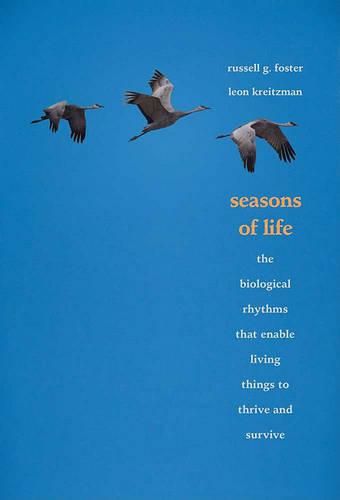Readings Newsletter
Become a Readings Member to make your shopping experience even easier.
Sign in or sign up for free!
You’re not far away from qualifying for FREE standard shipping within Australia
You’ve qualified for FREE standard shipping within Australia
The cart is loading…






Just as daily events are timed by living creatures through circadian rhythms, so seasonal events are timed through an internal calendar that signals birds to return to nesting grounds, salmon to spawn, plants to flower, squirrels to hibernate, kelp to stop growing.
In this fascinating book, Russell G. Foster and Leon Kreitzman draw on remarkable recent scientific advances to explain how seasonal change affects organisms, and how plants and animals over countless generations have evolved exquisite sensitivities and adaptations to the seasons. The authors also highlight the impact of seasonal change on human health and well-being. They conclude with a discussion of the dangers posed when climate changes disrupt the seasonal rhythms on which so much life depends.
Surprising facts from Seasons of Life:
-The timing of human birth has a small but significant effect on various later life attributes, such as handedness and the susceptibility to many illnesses, including multiple sclerosis and schizophrenia.
-Plants have the ability to measure the length of a period of light, and they germinate, flower, and successfully reproduce by using this information.
-Birds migrate not in response to weather changes but by using an internal calendar.
-Until recently, human birth was tightly coupled to the seasons, peaking in many societies in the spring.
-Just as internal 24-hour circadian clocks predict daily change, many animals have a circannual clock in their brains that predicts the seasons.
$9.00 standard shipping within Australia
FREE standard shipping within Australia for orders over $100.00
Express & International shipping calculated at checkout
Just as daily events are timed by living creatures through circadian rhythms, so seasonal events are timed through an internal calendar that signals birds to return to nesting grounds, salmon to spawn, plants to flower, squirrels to hibernate, kelp to stop growing.
In this fascinating book, Russell G. Foster and Leon Kreitzman draw on remarkable recent scientific advances to explain how seasonal change affects organisms, and how plants and animals over countless generations have evolved exquisite sensitivities and adaptations to the seasons. The authors also highlight the impact of seasonal change on human health and well-being. They conclude with a discussion of the dangers posed when climate changes disrupt the seasonal rhythms on which so much life depends.
Surprising facts from Seasons of Life:
-The timing of human birth has a small but significant effect on various later life attributes, such as handedness and the susceptibility to many illnesses, including multiple sclerosis and schizophrenia.
-Plants have the ability to measure the length of a period of light, and they germinate, flower, and successfully reproduce by using this information.
-Birds migrate not in response to weather changes but by using an internal calendar.
-Until recently, human birth was tightly coupled to the seasons, peaking in many societies in the spring.
-Just as internal 24-hour circadian clocks predict daily change, many animals have a circannual clock in their brains that predicts the seasons.